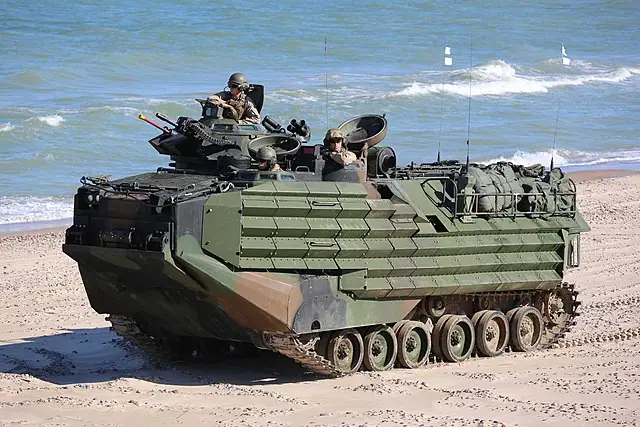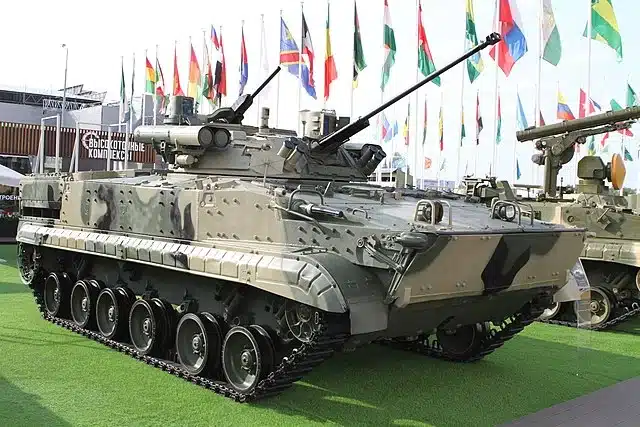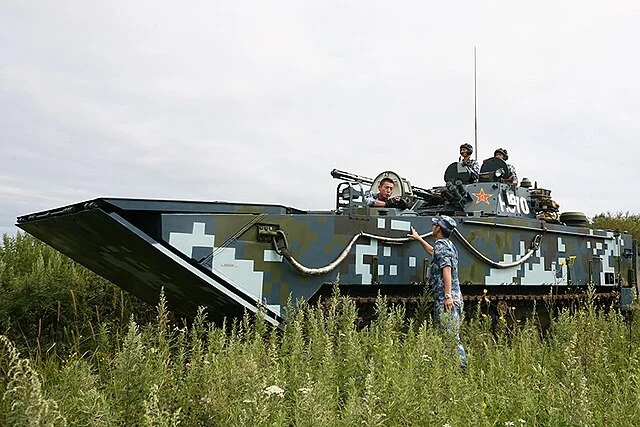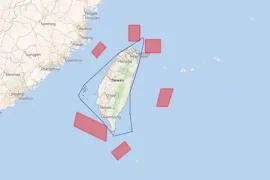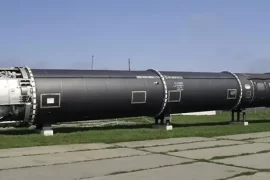Amphibious assault vehicles (AAVs) are essential tools in modern warfare, capable of seamlessly transitioning between water and land operations. These formidable machines play a pivotal role in amphibious assaults, enabling troops to rapidly deploy and carry out missions on hostile shores. In this article, we will explore the ten most powerful AAVs in the world, each designed for exceptional performance and versatility.
List of the 10 Most Powerful Amphibious Assault Vehicles
The top 10 most powerful amphibious assault vehicles are AAV7A1 Assault Amphibious Vehicle, BMP-3, ZBD-05, AIFV-B-C25, BTR-80, BvS 10 Viking, AAVP7A1 RAM/RS, Type 96, VAB, and Terrex 2.
AAV7A1 Assault Amphibious Vehicle (US)
The AAV7A1 is a battle-tested workhorse used by the United States Marine Corps. It can transport up to 21 combat-ready Marines and boasts a formidable 40mm MK19 automatic grenade launcher and .50-caliber M2 machine gun.
Affectionately known as “amtracs” by Marines, a shortened form of “amphibious tractor,” these vehicles have a rich history of service. Manufactured by U.S. Combat Systems, this fully tracked amphibious landing vehicle has played a pivotal role in numerous military operations including Falklands War, Iraq War and Persian Gulf War.
The AAV-P7/A1 transports troops and equipment during amphibious assaults. It allows for the rapid deployment of surface assault units from ships to inland objectives. Its versatility extends to mechanized operations, making it a key asset for combat support.
However, in June 2018, plans were set in motion to replace the AAV7A1 with the BAE Systems/Iveco wheeled SuperAV as part of the Amphibious Combat Vehicle (ACV) program. Next year, the US Marine Corps awarded BAE Systems a $67 million contract for developing three variants of Amphibious Combat Vehicles (ACVs): ACV-C, ACV-30, and ACV-R. In November, 2020, BAE Systems delivered the first batch of ACVs.
BMP-3 (Russia)
The BMP-3, hailing from Russia, stands as a reliable Infantry Fighting Vehicle, offering a formidable presence on both conventional battlefields and in NBC-contaminated zones. It serves as a versatile combat vehicle, effectively combining the roles of infantry fighting vehicle, tank destroyer, fire support platform, and amphibious personnel carrier. It boasts a top road speed of 70 km/h and a floating speed of 10 km/h, ensuring it can swiftly adapt to various operational scenarios with a cruising range of 600 kilometers.
The BMP-3 boasts an impressive arsenal. It includes a 100mm cannon-missile launcher, a 30mm automatic cannon, and a 7.62mm machine gun. Additionally, two 7.62mm hull machine guns further enhance its firepower.
To ensure precise targeting and operability, the BMP-3 can be equipped with modern sighting systems, offering day/night modes and low-visibility capabilities. The two-plane weapon stabilizer allows for accurate firing while on the move, both on rough terrain at speeds of up to 30 km/h and in water at Sea State 1.
With a crew of 3 and the capacity to carry 7 troopers (with the option for 2 additional seats), the BMP-3 is a versatile and formidable asset with a combat weight of 18.7 tons.
ZBD-05 (China)
The ZBD-05 is a lightweight, fast amphibious assault vehicle used by the People’s Liberation Army Marine Corps.
Its speed and maneuverability, combined with a 30mm automatic cannon and anti-aircraft missile systems, make it a potent force on both land and water.
Developed by Norinco for the People’s Liberation Army Navy Marine Corps, ZBD-05 represents an exceptional advancement in amphibious combat capabilities. One of the standout features of the ZBD-05 is its ability to be launched at sea from an amphibious assault ship over the horizon. It incorporates a hydroplane design concept, allowing for swift and efficient landing operations. This innovation has drawn comparisons to the canceled United States Expeditionary Fighting Vehicle (EFV) program.
With a mass of 26.5 tons and impressive dimensions, including a hull length of 9.5 meters (31 feet) and a width of 3.36 meters (11 feet), the Type 05 is a formidable presence on both land and water. It accommodates a crew of 3 for the infantry fighting variant and 4 for the light tank variant, along with 8 passengers.
The ZBD 05’s armored construction, featuring welded aluminum alloy and steel with composite armor plates, ensures robust protection. It is armed with a ZPT-99 cannon turret, a ZPL-98A 105mm rifled gun, and a complement of secondary weapons, including anti-tank and anti-aircraft capabilities. Powered by a diesel engine delivering 550 horsepower on land and 1475 horsepower in water, it achieves speeds of up to 65 km/h on land and 28-30 km/h on water.
AIFV-B-C25 (South Korea)
South Korea’s AIFV-B-C25 is an amphibious infantry fighting vehicle equipped with a 25mm dual-feed cannon and anti-tank guided missiles. Its ability to transport troops over water and provide heavy fire support makes it a versatile asset.
BTR-80 (Russia)
The BTR-80 is a well-known amphibious armored personnel carrier used by various nations. Armed with a 14.5mm machine gun, it can carry up to ten personnel across water and on land.
BvS 10 Viking (Sweden)
The BvS 10 Viking is a robust and highly mobile amphibious all-terrain vehicle designed for a variety of missions. It can carry up to 11 personnel and is equipped with machine guns, grenade launchers, and anti-tank missiles.
AAVP7A1 RAM/RS (US)
This upgraded version of the AAV7A1 features enhanced armor and mobility. It can transport up to 25 Marines and is armed with a .50-caliber machine gun and a 40mm grenade launcher.
Type 96 (Japan)
Japan’s Type 96 amphibious assault vehicle is designed for rapid troop deployment. It carries 25 troops and is armed with a 12.7mm machine gun, making it suitable for various combat scenarios.
VAB (France)
While primarily an armored personnel carrier, the VAB can be adapted for amphibious operations. It can transport up to 10 troops and is equipped with a 12.7mm machine gun.
Terrex 2 (Singapore)
The Terrex 2 is a versatile amphibious armored vehicle equipped with advanced communication systems and a 30mm automatic cannon. It can transport up to 13 personnel and is designed for rapid deployment in various environments.
Conclusion
The top 10 most powerful amphibious assault vehicles (AAVs) in the world are
- AAV7A1 Assault Amphibious Vehicle (US)
- BMP-3 (Russia)
- ZBD-05 (China)
- AIFV-B-C25 (South Korea)
- BTR-80 (Russia)
- BvS 10 Viking (Sweden)
- AAVP7A1 RAM/RS (US)
- Type 96 (Japan)
- VAB (France)
- Terrex 2 (Singapore)
In conclusion, amphibious assault vehicles represent a critical component of modern military forces, enabling rapid response and versatile operations in challenging coastal environments. These ten powerful AAVs from different nations showcase the diversity and capability of these machines, ensuring the safety and effectiveness of troops during amphibious operations. As technology continues to advance, we can expect even more impressive developments in the field of amphibious assault vehicles.

